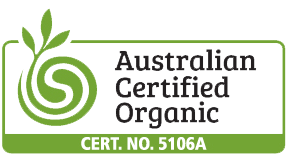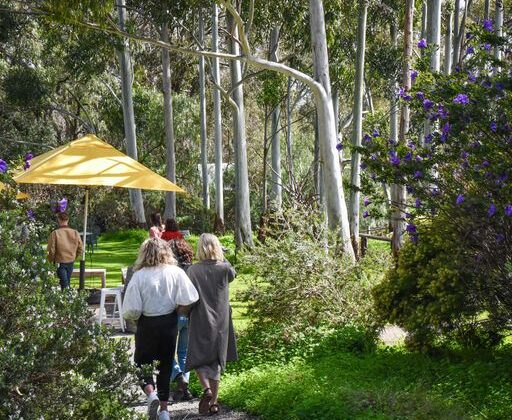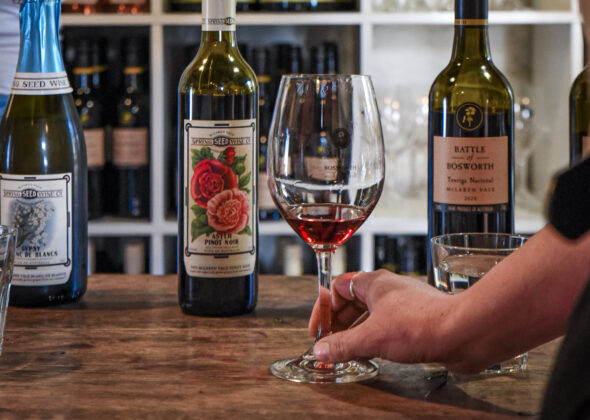Battle of Bosworth’s commitment to organic and sustainable viticulture is at the heart of our brand. For over 30 years, we’ve led the way in McLaren Vale with our environmentally conscious winemaking. We’re proud to be the first McLaren Vale vineyard to achieve Australian Certified Organic status.
Our Organic Journey:
Our approach is simple: work with nature, not against it. We combine time-honored farming practices with modern sustainable techniques to minimize our environmental impact. This means respecting the regional climate and embracing traditional agricultural techniques that have been proven for generations. Beyond our organic certification, we also hold Sustainable Winegrowing Australia certification, reflecting our ongoing commitment to continuous improvement in all aspects of sustainability.
What Does Organic Really Mean?
Organic farming is about minimizing external inputs. Our certified organic grapes are grown and processed without synthetic chemicals, fertilizers, or GMOs. At Battle of Bosworth, our organic viticulture fosters a healthy environment rich in flora, fauna, and nutrients – the ideal conditions for growing exceptional wine grapes. By eliminating harmful chemicals from the land, water, and air, we create a thriving ecosystem that benefits both the vines and the surrounding environment.
The Reward for our Efforts:
Our conversion to organic viticulture began in 1995. Today, we boast a significant holding of mature vines (30 years and older) including Shiraz, Cabernet Sauvignon, Chardonnay, Sauvignon Blanc, and Mourvèdre, along with smaller plantings of Malbec, Graciano, and Touriga Nacional. All are fully certified organic by Australian Certified Organic, a rigorous process that involves annual audits and random product sampling.
Old-Fashioned Grape Growing, Modern Sustainability:
Much of what we do is rooted in traditional grape growing methods, reminiscent of practices used 50 years ago, before the advent of synthetic pesticides and fertilizers. We believe in letting nature take its course as much as possible.

Innovative Weed Management:
We’ve developed a unique and sustainable weed management system. We encourage the growth of Soursobs (oxalis pes caprae) under the vines to naturally outcompete other weeds. We also utilize modified vineyard machinery to enhance efficiency and minimize our environmental footprint. Extensive re-vegetation projects, involving the removal of feral species and replanting of native flora, further enhance biodiversity and the natural beauty of our vineyards and creeks.
The Power of Soursobs:
The vibrant yellow Soursob flower, which graces our Battle of Bosworth label, plays a crucial role in our weed management strategy. Growing rapidly with the winter rains, Soursobs outcompete other weeds, creating a natural weed mat in spring and summer. Their lifecycle perfectly complements the grapevines, utilizing water during the vines’ dormant winter period and dying back in summer when the vines’ water requirements increase.
Cover Crops: A Vital Tool:
Cover crops are another essential component of our organic and sustainable viticulture. After the first rains in April/May, we plant a cover crop, typically triticale (a wheat-rye hybrid), between the vine rows. This practice enriches the soil with organic matter, helps retain moisture, and moderates soil temperature during the summer months. The cover crop is then mown in spring and left as a surface mulch, providing a natural weed barrier.
Minimizing Cultivation:
We prioritize minimal soil disturbance, recognizing its importance for maintaining soil structure. In some years, when weeds like wild oats become problematic within the Soursob population, we use a specialized “dodge plough” to remove soil under the vine and eliminate weeds, but only after the Soursobs have set their bulbs for the following season. A modified rotary hoe, designed to minimize cultivation, is used concurrently. More recently (since 2020) we have introduced the Clemens under vine weeder. The soil removed by the dodge plough and Clemens weeder is then placed back under the vine with a single “throwing on” disc, creating a weed-free area and replenishing the Soursob bulb population.

Stock Grazing, a mutually beneficial approach:
At our Kangaroo Island vineyard, acquired in 2016, we adhere to the same organic and sustainable principles, even though it’s not yet certified organic. We utilize sheep and lambs for winter grazing, providing them with pesticide-free forage while they help control weeds. Their manure naturally fertilizes the soil, adding essential nutrients and improving soil health.
Our Vineyards and Soils:
McLaren Vale:
Our vineyards are located in the southern foothills of the Mount Lofty Ranges which form the eastern boundary of the McLaren Vale wine region, approximately 7km west of the sea, at an elevation of around 130 meters. The soils are primarily Urrbrae silt loams, characterized by red-brown to chocolate brown clay loams with slate/quartz gravel over red-brown, stony clay. These well-drained soils possess excellent water-holding capacity, supplemented by drip irrigation when necessary.
Kangaroo Island:
Our Kangaroo Island vineyard at Cygnet River enjoys a unique combination of low rainfall, low soil fertility, and a moderate maritime climate. This terroir results in low-yielding vines that produce intensely flavored and highly colored wines. The island’s GMO-free status further aligns with our commitment to pure and natural winemaking. The soils here are predominantly sandy loam over limestone and marl, with patches of Bay of Biscay soils and some ironstone.

The Vines:
Most of our vines are trained to a two-wire vertically shoot positioned spur pruned trellis. Joch has been transitioning some blocks to a single-wire spur pruned system. The “cordon cut” rows, used for our vine-dried Shiraz (and the “White Boar” material), are trained to a single-wire cordon with spur and cane vertically shoot positioned. Our Cabernet Sauvignon vines are LC10 and LC14 clones, while our Shiraz is a blend of 1664 and a very old, unidentified McLaren Vale clone. The vines are approximately 20 years old. Our Chardonnay plantings consist of the I10VI clone, and the Viognier is a mix of Montpellier and HTK clones. Vine density averages around 664 vines per acre across all varieties.
Our Certifications, Your Guarantee
Our Organic and Sustainable Winegrowing certifications independently managed and audited annually, they are your assurance that we do what we say, and you can enjoy our wines with confidence.
Like to learn more about Australian Certified Organic and Sustainable Winegrowing Australia certification? Click on the icon below to visit their website.







